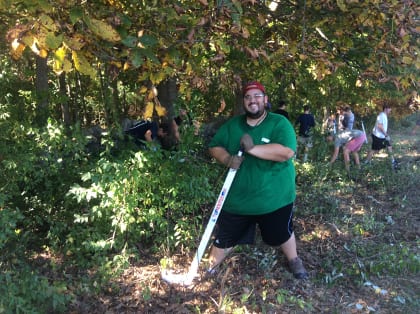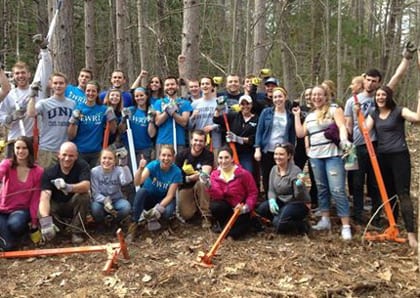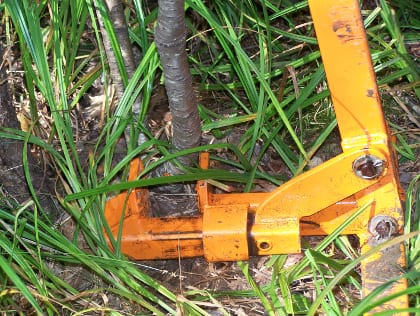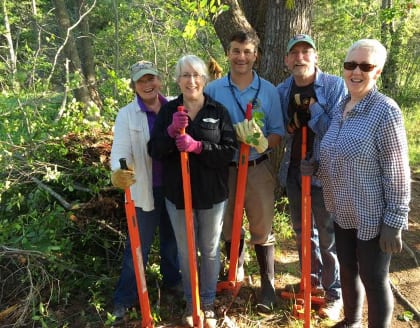by Melissa Brogle
Invasive plants can have a detrimental impact on habitats and watersheds, including the Great Bay watershed in New Hampshire. However, to make their invasive control/removal efforts more effective and a little easier, groups working to combat invasive plants on the seacoast can borrow some tough “weed wrenching” tools.

The Nature Conservancy uses weed wrenching tools borrowed through the GBNERR tool loan program to clear invasive plants on one of their properties in the Great Bay watershed.
The Great Bay National Estuarine Research Reserve (GBNERR), a part of the New Hampshire Fish and Game Department, has a tool loan program available for organizations and individuals to help combat invasive plants. The tool loan program was initially funded by the Lamprey River Advisory Committee and has been very successful since early 2011.
“The goal of this program is to provide an easy, free way for conservation commissions, land trusts, natural resource managers, restoration ecologists, individual landowners and other conservation partners to carry out community invasive plant control projects,” said Rachel Stevens, Stewardship Coordinator for the Great Bay National Estuarine Research Reserve.

A group of students and staff from The UNH Office of the Woodlands tackle buckthorn with their borrowed tools on their semi-annual workday.
A Stockpile of Shared Tools
The program established a storehouse of specialized tools to be used as a community resource. The tools, often referred to generically as weed wrenches though there are several manufacturers of similar tools, are useful for manual removal of woody stemmed invasive plants such as glossy buckthorn, autumn olive, multiflora rose, and honeysuckles. Currently, more than 40 weed wrenches are available in three different sizes – enough tools to equip large work groups. The program also offers planting bars, or dibbles, to assist in native planting projects.
The tools are housed at the Great Bay Discovery Center in Greenland, NH, and are available on a first-come, first-served basis. There is no charge for borrowing the tools, and groups and individuals simply fill out a short survey to request tools. (Refer to link below.) This survey helps the Reserve track the use of the tools, and also analyze the types of invasive species that are being targeted by local groups and landowners.
A History of Success
Since 2011, the tools have been loaned to 115 groups or individuals for many different invasive removal projects. According to tool borrowers, the weed wrenches have been used to remove autumn olive, common and Japanese barberry, common and glossy buckthorn, honeysuckles, multiflora rose, Norway maple, and privet. The most common invasives that survey respondents use the tools for have changed over the years. In 2014 and 2015, common and glossy buckthorn are the most common plants that borrows are using the tools to tackle in the Great Bay watershed, with some large workdays tackling plant stands of up to 1000 plants!

As the volunteer bears down on the handle, the Weed Wrench grasps the woody stem of an invasive plant and wrenches the plant out of the ground.
The great thing about the weed wrenches is that they are not only tough, but are heavy enough to provide some leverage when removing woody invasive plants. Many of the invasives in the area cannot simply be pulled out of the ground by hand because the stems and roots are strong, but these tools make the job much more manageable. The Reserve is thrilled to offer the weed wrenches because it not only provides great tools for the job, but helps local organizations and landowners get involved in invasive control without having to spend money on tools.

Portsmouth Conservation Commission uses the Weed Wrenches to remove buckthorn as part of one of their 2015 workdays.
Support for Native Plant Populations
The more people involved in invasive control, the better chance the Great Bay watershed has of tackling some of the tough invasives, which helps to ensure that our native plants have a chance to thrive. If native plants can thrive, then native wildlife will also thrive, making the Great Bay watershed healthier for all of us.
New Hampshire’s Great Bay and coastal watersheds are a region of great biodiversity within the state and include special habitats such as pitch pine barrens, Appalachian oak-pine forest, salt marshes, and emergent and shrub wetlands. Invasive plants know no boundaries and frequently impact these vegetative communities and the wildlife they support.
The Great Bay National Estuarine Research Reserve is one of several partners in the regional New Hampshire Coastal Watershed Invasive Plant Partnership, which aims to protect the ecological integrity of natural habitats and economic vitality of managed lands in New Hampshire’s coastal watershed through activities that reduce the threat of invasive plants. Learn more about invasive plant control options on New Hampshire’s seacoast at http://www.wildlife.state.nh.us/invasives/options.html.
Visit the Great Bay National Estuarine Research Reserve at http://www.greatbay.org.
If you are interested in borrowing the Weed Wrenches please fill out the online Tool Loan Survey available at http://svy.mk/1CHoIvD.
Editor’s Note: In 2018, Great Bay’s tools were donated to Nature Groupie, which now has an extensive tool loan library.
About the Author
Melissa Brogle is the Volunteer Coordinator at the Great Bay National Estuarine Research Reserve. Melissa has 5 years of experience managing volunteers and helps facilitate the tool loan program at The Reserve. In 2014 The Reserve had a very successful year for volunteers with over 3,000 hours of volunteer time donated to The Reserve across the four core programs.

